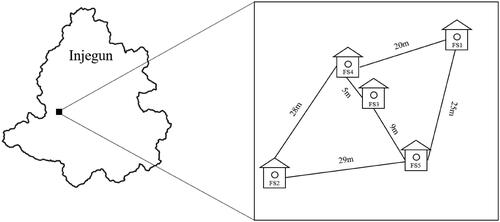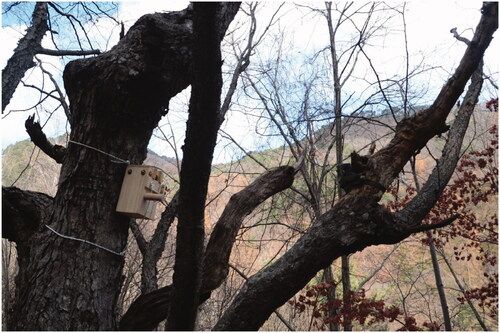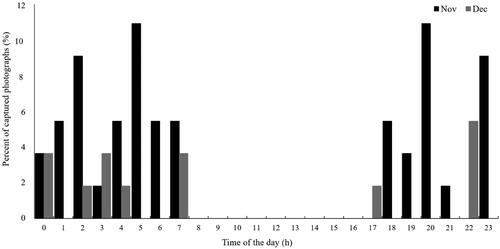Abstract
Siberian flying squirrel (Pteromys volans) is an endangered nocturnal flying mammal inhabiting the conserved forests in the Korean Peninsula. This study investigated the artificial nest usage patterns of a released Siberian flying squirrel individual and other wild species inhabiting the area using trail cameras. Our observations indicated that the released Siberian flying squirrel preferred artificial nests with an entrance diameter of 4 cm rather than 6.5 cm installed in the study area. Additionally, the Siberian flying squirrel used at least four nests. During winter, Eurasian nuthatch bird species competed with the Siberian flying squirrel for the nests. Therefore, to reduce competition for nests, further research on the nest entrance size, nest depth, and insulation material preferred by the Siberian flying squirrels and Eurasian nuthatch birds is necessary. This study provides significant information on whether artificial nests installed in areas, where rescued Siberian flying squirrels are released, can be used as early nesting sites by the Siberian flying squirrels to facilitate their easy re-settlement in the natural habitats.
Introduction
Siberian flying squirrel, a small mammal belonging to the Sciuridae family of the Rodentia order, thrives across the northern Eurasian continent, with small local populations present in the conserved forest areas (Hanski et al. Citation2000; Jo et al. Citation2018).
It is an arboreal nocturnal animal, gliding through trees using a flying membrane and feeding on seeds and leaves (Asari and Yanagawa Citation2009; Woo et al. Citation2013). It generally prefers tree cavities with small entrances of size 3–5 cm and at a height of 2.8 m or higher (Suzuki et al. Citation2013). Tree cavities created by woodpeckers and naturally created tree cavities are used as nesting sites (Hanski et al. Citation2000).
The population of Siberian flying squirrels has been recently decreasing due to deforestation and habitat loss caused by timber harvesting (Airapetyants and Fokin Citation2004; Woo et al. Citation2013). In Korea, the Siberian flying squirrel was designated as a natural monument by the Cultural Heritage Administration. Furthermore, it was designated as an endangered species by the Korean Ministry of Environment in 1998. Changes in the forest structure caused by anthropogenic sources not only have detrimental effects on woodpeckers, which create cavities in trees, but also reduce the proportion of mature trees that are necessary for tree cavities and for abundant food production. Consequently, this reduces the proportion of tree cavities that are used as nests by Siberian flying squirrels (Hanski Citation1998, Citation2006; Suzuki et al. Citation2011). Moreover, Siberian flying squirrels compete with birds that also use tree cavities. Thus, the decline in tree cavities will further intensify the competition for nests between Siberian flying squirrels and such birds (Harlow and Lennartz Citation1983; Rudolph et al. Citation1990; Loeb Citation1993; Miller Citation2002; Borgo et al. Citation2006).
Research on artificial nests that can used instead of tree cavities is actively underway to reduce the competition for nesting sites among species living in forests having damaged vegetation or changing vegetative structures. Installing artificial nests can ameliorate the competition for nesting sites and also reduce encroachment by flying squirrels in tree cavities used by red-cockaded woodpeckers (Borgo et al. Citation2006).
Artificial nests have also drawn attention as a way to preserve another arboreal mammals (Beyer and Goldingay Citation2006; Warakai et al. Citation2013; Sotola and Garneau Citation2014; Goldingay et al. Citation2015). In particular, it has been known to possibly be useful for the reintroduction of the red squirrel (Shuttleworth Citation1999; Shuttleworth and Schuchert Citation2014).
This study aimed to identify whether artificial nests installed in areas, where rescued Siberian flying squirrels were released, can be used as early nesting sites to facilitate the stable re-settlement of the released Siberian flying squirrels.
Materials and methods
Selection of release areas for the Siberian flying squirrel and installation of artificial nests
For this study, we used a rescued individual. Since the habitats where the individual has been rescued was disturbed and unsuitable, the individual was released into new habitats. The Gaetgol in Injegun, Gangwon-do, where traces of Siberian flying squirrel excrement were found, was selected for releasing a Siberian flying squirrel and installing artificial nests. Deciduous trees were used for the artificial nests with the size of 10,400 cm3 (20 cm in length × 20 cm in width × 26 cm in height) and foothold for flight leaps. Five artificial nests were installed on five different trees at a height of 3 m or higher. Nests were numbered as FS1–FS5 (). The diameter of the entrance of FS2–FS5 was 4 cm and it was 6.5 cm for FS1.
Released Siberian flying squirrel individual
An adult male Siberian flying squirrel that was rescued in September 2017 by the Species Restoration Technology Institute of the Korean National Park Service. The individual was released after 47 days of the rescuse under the supervision of the wildlife veterinarian who belongs to the Institute of Speies Restoration Technology Institute of Korean National Park Service. The Siberian flying squirrel individual was distinguished with tags on the back and hair cutting on tail. The tag for individual recognition was size of 2730 mm3 (21 in length × 13 in width × 10 in height) and weight of 3.5 g under 5% of the individual weight (84.7 g). If the weight of the transmitter attached to flying animals is less than about 5%, behavioral restrictions can be minimized (Aldridge and Brigham Citation1988). After 12 days of adaptation training in FS5 that was filled with insulation material (shredded paper and cotton), the Siberian flying squirrel individual was released on November 15. The entrance to FS5 that contained the Siberian flying squirrel was sealed and was relocated to the study area where the other artificial nests (FS1–FS4) were pre-installed. FS5 was installed in this study area and its seal was removed. Permission for changing the current state of cultural properties was acquired from the Cultural Heritage Administration.
Camera trapping
Trail cameras (Force 10, Spypoint, USA, and M990i, Moultrie, USA) were used to investigate the artificial nest usage patterns of the released Siberian flying squirrel and other wild species in the study area that generally used tree cavities. The cameras were installed at a distance of 1–1.5 m facing the artificial nest entrance () and were operational for 42 days from 15 November to 26 December 2017. The photography mode of the cameras enabled three consecutive shots to be taken in 1 min after detecting an animal. Two or more consecutive photographs captured by the cameras within 1 min were considered as one photograph. In addition, duplicate photographs taken because of a single individual staying at the nest entrance for long duration. At our observations, the Siberian flying squirrels were stayed for a period of 2–10 min under camera view after arrival to the artificial nests, or for departure from the nests. Thus, photographs of a single individual re-photographed at the same nest within 10 min were processed as one photograph.
Results
During the study period, 654 photographs of wild species were taken at the five artificial nests. Among these, 146 photographs were used for final analysis after eliminating photographs of the same individual that were captured within 1 min. Five species, including P. volans (Siberian flying squirrel), Sitta europaea (Eurasian nuthatch), Sittiparus varius (varied tit), Parus major (great tit), and Martes flavigula (yellow-throated marten), were photographed in at least one of the five artificial nests. Among the photographs of the five species, photographs of P. volans accounted for 52% (76 photographs), followed by those of S. europaea at 35% (51 photographs), and of S. varius at 10% (15 photographs). P. major and M. flavigula were rarely photographed, accounting for only 2% (three photographs) and 1% (one photograph) of the total photographs, respectively (). Among the 146 photographs, 94 (64.3%), 26 (17.8%), 13 (8.9%), 9 (6.2%), and 4 photographs (2.7%) were captured in the FS5, FS2, FS3, FS4, and FS1 nests.
Figure 3. Percentage of photographs of five species (out of the total photos, N = 146) in the artificial nests captured by the installed camera traps.
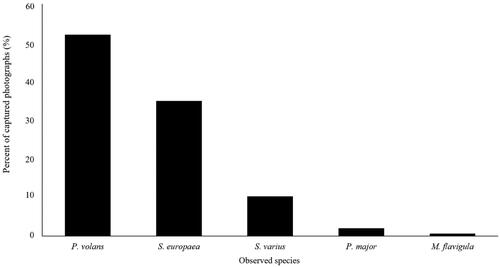
The released Siberian flying squirrel was photographed in all the installed artificial nests within 11 days of the release (), with the highest frequency in FS5. Among the total number of nest photographs (75), the released Siberian flying squirrel visited FS1, FS2, FS3 and FS4, and FS5 2 times (2.67%), 9 times (12%), 5 times (6.7%), and 54 times (72%), respectively. One Siberian flying squirrel individual other than the released individual was photographed only once in FS5 on December 25 (). FS1 was only photographed twice during the first two days of the release. The released Siberian flying squirrel was not photographed in any of artificial nests for 8 days from December 10 to 17 ().
Figure 4. Percentage of photographs for different species in the artificial nests (FS1–FS5) captured by the installed camera traps. The number of photographs captured at FS1, FS2, FS3, FS4, and FS5 were 4, 26, 13, 9, and 94, respectively.
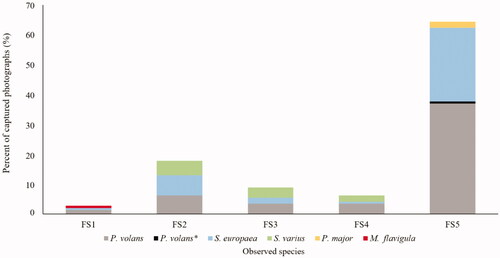
Figure 5. Percentage of photographs of the Siberian flying squirrel captured at each nest box during different days of the monitoring period. The Siberian flying squirrel was photographed 75 times in all the five nest boxes during the monitoring period.

The Eurasian nuthatch, which was the second most frequently photographed species in the artificial nests after the Siberian flying squirrel, was photographed in all the five nests and most frequently in FS5, where the Siberian flying squirrel was also most frequently photographed. Among the total number of nest photographs (51), the Eurasian nuthatch was photographed in the FS5, FS2, and FS3 nests 36 times (71%), 10 times (19.6%), and 3 times (5.9%), respectively, and only once each in FS1 and FS4 during the early stages of nest installation (). Of the total of 42 days of monitoring, the Siberian flying squirrel and Eurasian nuthatch were photographed on 22 days in the FS5 nest. Among these 22 days, the two species were photographed on the same day for 12 days (55%).
The varied tit was photographed only in FS2, FS3, and FS4. Seven out of 15 shots (47%) were photographed in FS2, followed by five (33%) in FS3, and three (20%) in FS4. The great tit was photographed thrice only in the FS5 nest, while the marten was photographed only once in the FS1 nest ().
Analysis of the time of the photographs of the artificial nests showed that the Siberian flying squirrel was photographed in the nests from 17:00 to 18:00 in the evening, before 07:00 and 08:00 in the morning, and was most frequently photographed from 02:00 to 03:00, and 20:00 to 21:00. It was more active at dawn than in the evening (). The Eurasian nuthatch was photographed in the nests from 07:00 to 08:00, after 16:00–17:00, and was most frequently photographed between 09:00 and 10:00 (). The varied tit was photographed in the artificial nests at the same time in the morning as the Eurasian nuthatch, but it was not photographed after 13:00–14:00 and was photographed mostly during 08:00–09:00 and 12:00–13:00 ().
Figure 6. Daily activity patterns of the five species. The number of photographs of P. volans, S. europaea, S varius, S. major, M. flavigula, and P. volans* were 75, 51, 15, 3, 1 and 1, respectively. (P. volans* means wild Siberian flying squirrel, not the released individuals).
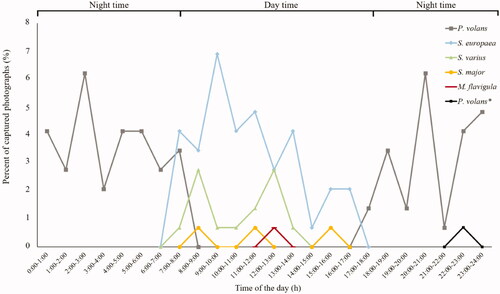
A monthly comparison of the temporal patterns of daily activities of the released Siberian flying squirrel indicated that it was more active in November than in December. In November, it was active at all hours of the night, while it was mostly inactive in the night in December, except during the time period of 01:00–02:00, 05:00–07:00, 18:00–22:00, and 23:00–24:00 ().
Discussion
This study investigated the artificial nest usage patterns of a released Siberian flying squirrel individual and of other wild species inhabiting the release area using camera traps. Among the five artificial nests installed in the study area, the released Siberian flying squirrel visited nests more frequently to an entrance of 4 cm diameter than 6.5 cm, in accordance with the results (preference for nests with entrance of a 5 cm in diameter) of the previous study which was conducted in South Korea (Kim et al. Citation2019).
The Eurasian nuthatch, which was the second most frequently photographed species after the Siberian flying squirrel, was also photographed more frequently in artificial nests having the same entrance dimensions. According to a previous study (Wesołowski and Rowiński Citation2004), the preferred diameter size of the tree cavity used by the Eurasian nuthatch as a nest was 2.9–3.3 cm, and is thus, consistent with the results of this study.
This preference of the Siberian flying squirrel and Eurasian nuthatch for narrow entrances may be in response to predation pressure. In addition to the Siberian flying squirrel (P. volans) inhabiting Russia and Japan, the Southern flying squirrel (Glaucomys volans) inhabiting North America, prefers tree cavities with narrow entrances for nesting (Airapetyants and Fokin Citation2004; Kadoya et al. Citation2011; Suzuki et al. Citation2013). In this study, the yellow-throated marten was observed exploring the inside of the nest by pushing its forelegs through the entrance of the artificial nest of the Siberian flying squirrel. Therefore, this might indicate that the Siberian flying squirrel preferred narrow nest entrances to avoid not only terrestrial predators, such as the marten, but also arboreal predators, such as owls. In this study, however, since we used only one nest with entrance of 6.5 cm, in further studies, more artificial nests should be employed to obtain reliable results for entrance preference.
Male Siberian flying squirrels are known to use seven or eight nests (Hanski et al. Citation2000). During the study period of 42 days, the released Siberian flying squirrel was not photographed in any of the artificial nests for 15 days, which included 8 days from December 10 to 17. During this period, the Siberian flying squirrel is presumed to have resided in natural tree cavities made by woodpeckers instead of artificial nests. Therefore, similar to the findings of a previous study (Hanski et al. Citation2000), the released Siberian flying squirrel in this study also appeared to have used at least four different nests.
The released Siberian flying squirrel was photographed most frequently in the FS5 nest, which included paper as the insulation material, possibly because it had used the same nest during the nest adaptation period prior to release. Therefore, it may have preferred this already familiar nest after its release. In addition, November and December, during which the Siberian flying squirrel was released and monitored, are early winter months, during which temperatures are low, thereby resulting in the preference of FS5 that had the insulation material. Further studies using video mode setting of cameras are needed for understanding the visiting purpose to artificial nests.
According to the photography time of the species in artificial nests, the active hours of the Siberian flying squirrel, Eurasian nuthatch, and varied tit overlapped from 07:00 to 08:00 in the morning, but did not overlap in the evening. The varied tit was rarely photographed and was not photographed after 13:00–14:00. Although the photography time for the Siberian flying squirrel, Eurasian nuthatch, and varied tit did not overlap with other important photography hours during the day, we assumed that these three species may compete for artificial nests.
The findings of this study demonstrate that artificial nests can assist in the initial settlement of the released Siberian flying squirrels into the natural habitats. Furthermore, artificial nests with a diameter of 4 cm are probably more significant as winter shelters since they can serve as nests not only for Siberian flying squirrels but also for arboreal species, such as the Eurasian nuthatch and varied tit. However, since the Eurasian nuthatch is assumed to compete with the Siberian flying squirrels for nests during winter, further research on the nest entrance size, nest depth, and insulation material preferred by the Siberian flying squirrel and Eurasian nuthatch is necessary to reduce interspecies competition for nesting sites.
Acknowledgments
We deeply appreciate for the helps of Jang Ik Son, head of the Bukbu Conservation Center of Korea National Park Service.
Disclosure statement
No potential conflict of interest was reported by the author(s).
Additional information
Funding
References
- Airapetyants AE, Fokin IM. 2004. Biology of European flying squirrel Pteromys volans L. (Rodentia: Pteromyidae) in the north-west of Russia. RusJTheriol. 2(2):105–113.
- Aldridge HDJN, Brigham RM. 1988. Load carrying and maneuverability in an insectivorous bat: a test of the 5% “rule” of radio-telemetry. J Mammal. 69(2):379–382.
- Asari Y, Yanagawa H. 2009. Movement of the Siberian flying squirrel, Pteromys volans orii, in fragmented small woods. Biosph Conserv Nat Wildl Hum. 9(2):13–17.
- Beyer GL, Goldingay RL. 2006. The value of nest boxes in the research and management of Australian hollow-using arboreal marsupials. Wildl Soc Bull. 33(3):161–174.
- Borgo JS, Conover MR, Conner LM. 2006. Nest boxes reduce flying squirrel use of red‐cockaded woodpecker cavities. Wildli Soc Bull. 34(1):171–176.
- Goldingay RL, Rueegger NN, Grimson MJ, Taylor BD. 2015. Specific nest box designs can improve habitat restoration for cavity‐dependent arboreal mammals. Restor Ecol. 23(4):482–490.
- Hanski IK, Stevens PC, Ihalempiä P, Selonen V. 2000. Home-range size, movements, and nest-site use in the Siberian flying squirrel, Pteromys volans. J Mammal. 81(3):798–809.
- Hanski IK. 1998. Home ranges and habitat use in the declining flying squirrel Pteromys volans in managed forests. Wildlife Biol. 4(1):33–46.
- Hanski IK. 2006. Assessment of the size of the Siberian flying squirrel Pteromys volans population in Finland, Final Report. Helsinki, Finland.
- Harlow RF, Lennartz MR. 1983. Interspecific competition for red-cockaded woodpecker cavities during the breeding season in South Carolina. p. 41-43 in D. A, Wood, ed. Red-cockaded Woodpecker Symposium II Proc., Florida Game and Fresh Water Fish Comm., U.S. Fish and Wildlife Service and U.S. Forest Service.
- Jo YS, Baccus JT, Koprowski JL. 2018. Mammals of Korea. Incheon: National Institute of Biological Resources. p. 470–472.
- Kadoya N, Iguchi K, Matsui M, Okahira T, Kato A, Oshida T, Hayashi Y. 2011. A preliminary survey on nest cavity use by Siberian flying squirrels, Pteromys volans orii, in forests of Hokkaido Island, Japan. RusJTheriol. 9(1):27–32.
- Kim JU, Lee WS, Lee EJ. 2019. The use of artificial nest boxes by Siberian flying squirrels (Pteromys volans) in South Korea. J for Res. 30(3):1131–1137.
- Loeb SC. 1993. Use and selection of red-cockaded woodpecker cavities by southern flying squirrels. J Wildl Manage. 57(2):329–335.
- Miller KE. 2002. Nesting success of the great crested flycatcher in nest boxes and in tree cavities: are nest boxes safer from nest predation? Wilson Bull. 114(2):179–185.2.0.CO;2]
- Rudolph DC, Conner RN, Turner J. 1990. Competition for red-cockaded woodpecker roost and nest cavities: effects of resin age and entrance diameter. Wilson Bull. 101:23–36.
- Shuttleworth C, Schuchert P. 2014. Are nest boxes a useful tool in regional red squirrel conservation programs? Htstrix. 25(2):91–94.
- Shuttleworth CM. 1999. The use of nest boxes by the red squirrel Sciurus vulgaris in a coniferous habitat. Mamm Rev. 29(1):63–68.
- Sotola VA, Garneau DE. 2014. Survey of the patterns of nest box use among squirrels (Sciuridae) in managed forest stands in Clinton County, New York. TOECOLJ. 7(1):1–8.
- Suzuki K, Mori S, Yanagawa H. 2011. Detecting nesting trees of Siberian flying squirrels (Pteromys volans) using their feces. Mammal Study. 36(2):105–108.
- Suzuki K, Sagawa M, Yanagawa H. 2013. Nest cavity selection by the Siberian flying squirrel Pteromys volans. Hystrix. 24(2):187–189.
- Warakai D, Okena DS, Igag P, Opiang M, Mack AL. 2013. Tree cavity-using wildlife and the potential of artificial nest boxes for wildlife management in New Guinea. Trop Conserv Sci. 6(6):711–733.
- Wesołowski T, Rowiński P. 2004. Breeding behaviour of Nuthatch Sitta europaea in relation to natural hole attributes in a primeval forest. Bird Study. 51(2):143–155.
- Woo D, Choi T, Lee S, Ha J. 2013. A study on dropping behavior and survey improvement methods for Siberian flying squirrel (Pteromys volans). Environ Impact Assess. 22(6):569–579.

